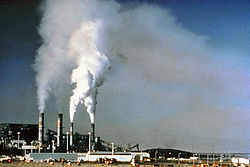On May 30th 2014, the Minister of the Environment commented on the planning phase environmental impact statement* (read here, Japanese only) for the Hibiki natural gas-fired power plant (1600MW), set to be built in Kitakyushu City, Fukuoka. The Minister stressed three points to utility companies in reducing CO2 emissions for new natural gas-fired power plants.
 First, the minister urged utilities to reduce their overall power sector’s CO2 emissions by substituting electricity generated from a newly developed 1600MW plant for the equivalent power generation by older plants, which requires other companies to end operations at older plants. Second, the minister requested the electric power industry to form a voluntary framework as early as possible. Third, the minister also requested utilities to consider CCS (carbon capture and storage) technology given that the power plants are anticipated to still be in use by 2050. Furthermore, the minister requested that the Ministry of Economic, Trade and Industry (METI) urge the electric power industry to form the voluntary framework at an early stage in order to guarantee that the electric power industry is consistent with national climate targets.
First, the minister urged utilities to reduce their overall power sector’s CO2 emissions by substituting electricity generated from a newly developed 1600MW plant for the equivalent power generation by older plants, which requires other companies to end operations at older plants. Second, the minister requested the electric power industry to form a voluntary framework as early as possible. Third, the minister also requested utilities to consider CCS (carbon capture and storage) technology given that the power plants are anticipated to still be in use by 2050. Furthermore, the minister requested that the Ministry of Economic, Trade and Industry (METI) urge the electric power industry to form the voluntary framework at an early stage in order to guarantee that the electric power industry is consistent with national climate targets.
These comments are based on MoE and METI’s agreement concerning TEPCO’s thermal power bid in April 2013 (read more here, Japanese only). The agreement requested that the electric power industry form a voluntary framework, and take measures to keep additional emission levels on par with emissions from natural gas. This time, the Minister of Environment gave a similar statement on the Hibiki power plant project even though the plant is a natural gas plant, not coal. However, the minister took the same position concerning CO2 emission reductions.
It is worth paying attention to how closely Saibu Gas, the utility set to operate the plant, follows MoE and METI’s agreement of adopting CO2 mitigation measures during the planning phase. For the 2 coal-fired power plant set to be built in Fukushima by TEPCO as well as the 2 plants that resulted from their bid (both to be built in Ibaraki), their planning phase impact statement do not reflect the measures put forth by MoE and METI. Judging from this, it is quite doubtful if utilities will attach any importance to the agreement by MoE and METI or if there are even aware of any such remarks.
The upcoming scope document (which will detail how the environmental assessment will be conducted) for the Hibiki power plant project is sure to be heavily evaluated by both MoE and Japanese NGOs. Regardless, it is imperative that the CO2 reduction measures of coal-fired power plants should be strictly evaluated. The comments by the Environment Minister concerning the impact statements of these coal-fired power plants is key for the next step in the process.
※As part of the environmental assessment process, corporations are obligated to draw up an environmental impact statement before establishing a new power plant that exceeds a certain size. It is the first document that investigates the project’s impact on the atmosphere and ecosystems. This process is open for comments by not only the Minster of the Environment, but also the public for a set period of time.

